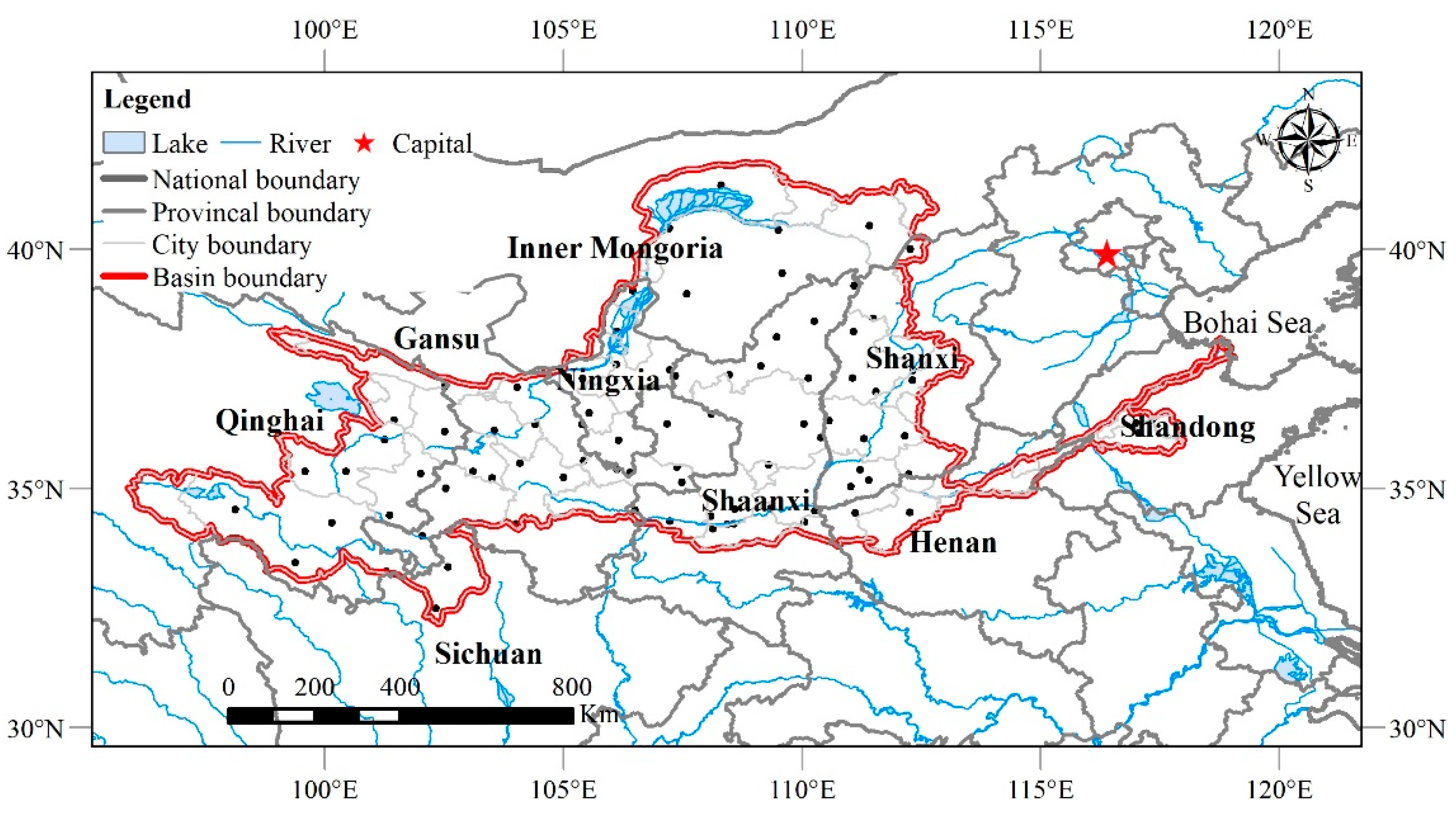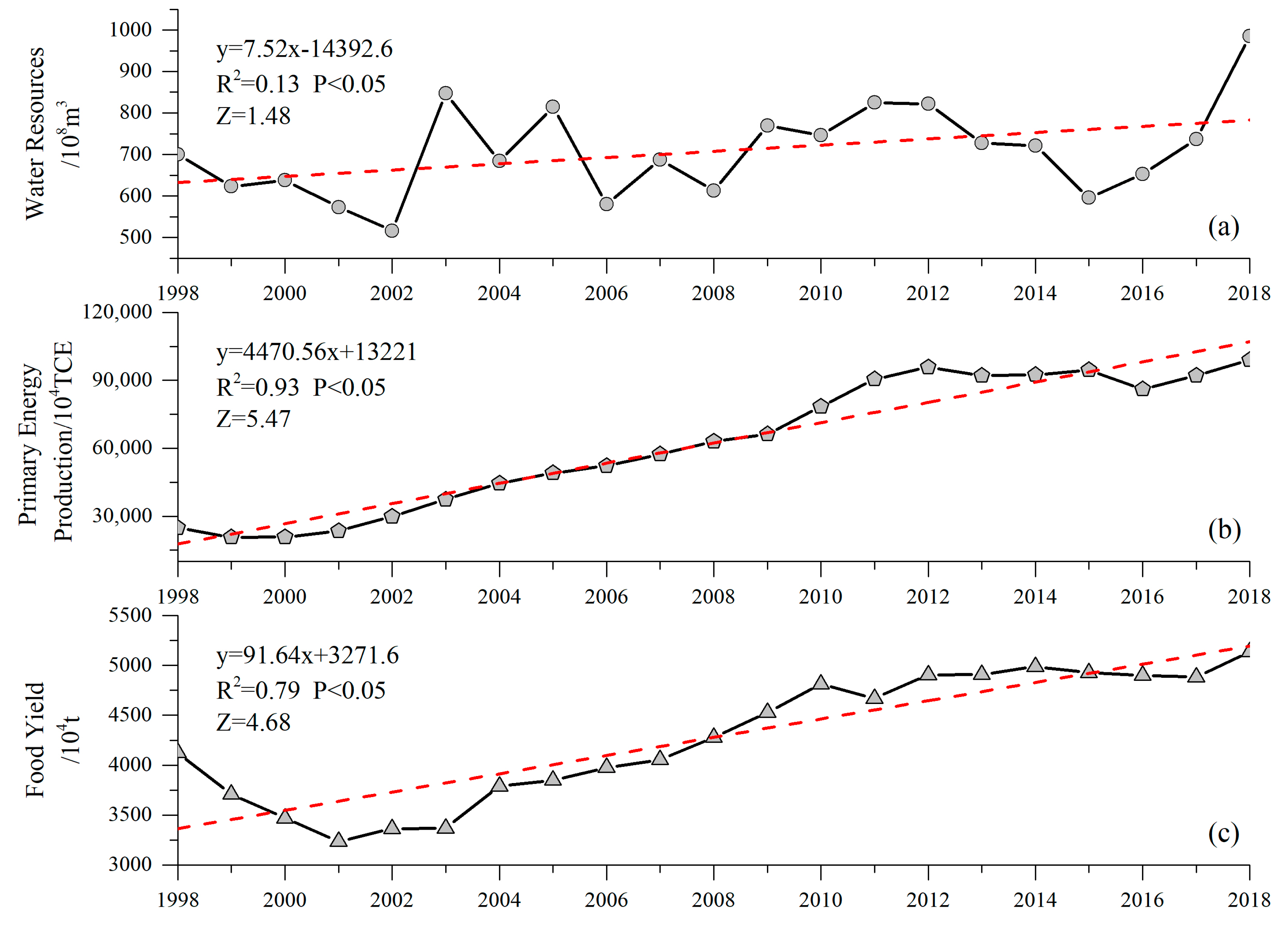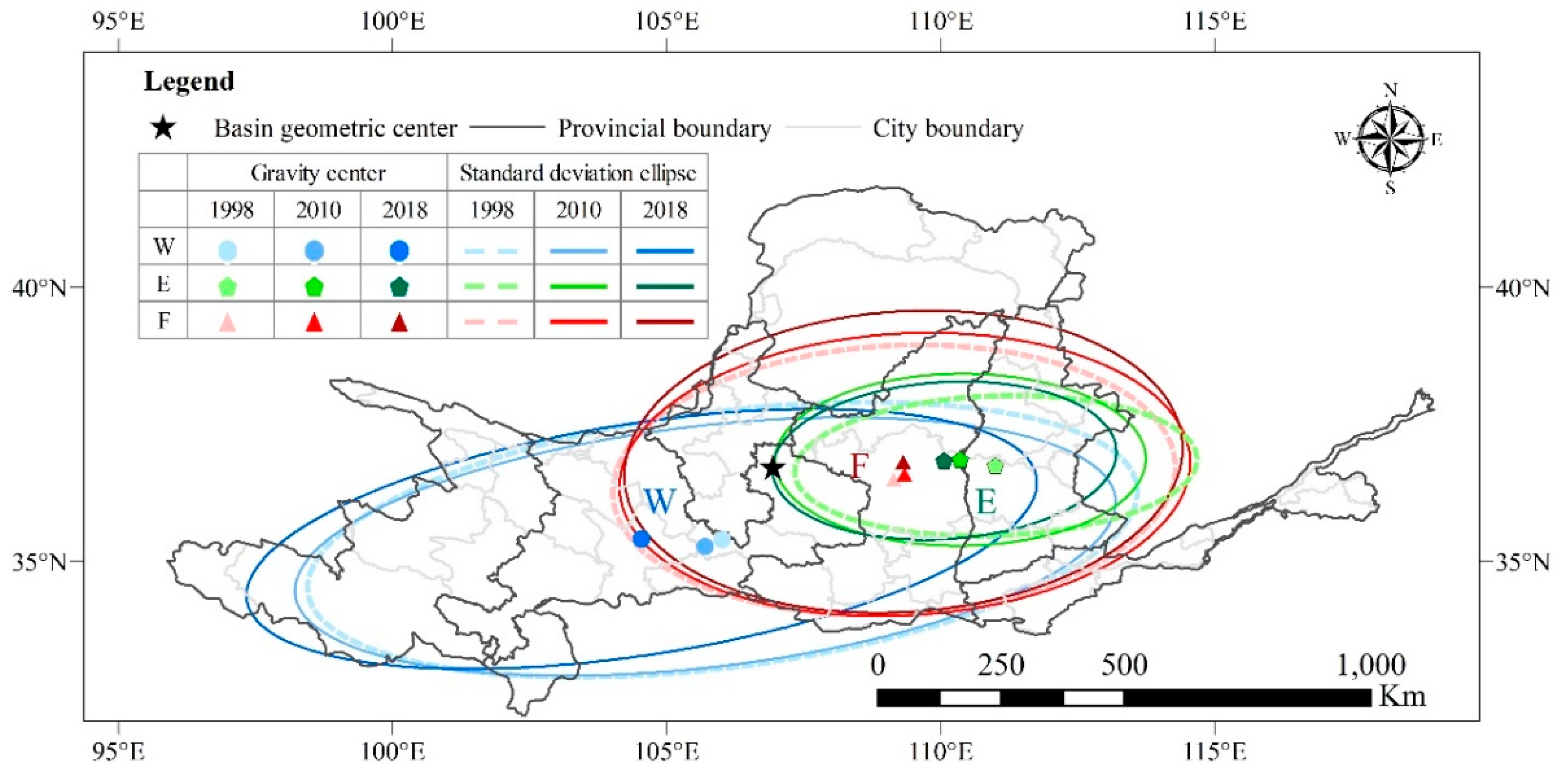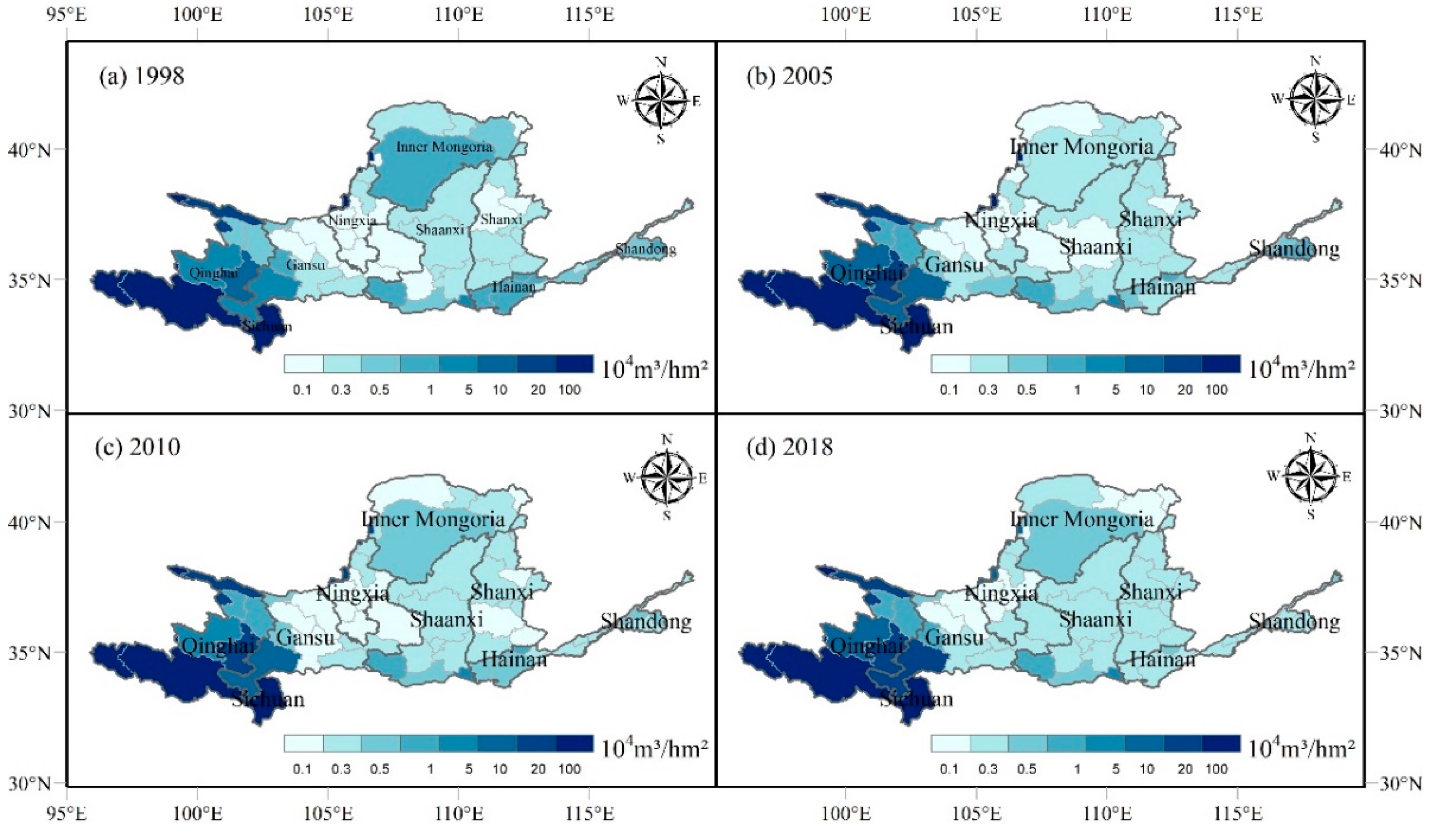Spatio-Temporal Matching and Nexus of Water–Energy–Food in the Yellow River Basin over the Last Two Decades
Abstract
:1. Introduction
2. Study Area and Dataset
2.1. Study Area
2.2. Dataset
3. Methodology
3.1. Standard Deviation Ellipse and Resource Center of Gravity Transfer
3.2. Lorentz Curve and Gini Coefficient
3.3. Resource Matching Coefficient Method
3.4. Multivariate Joint Probability Distribution Based on Copula Function
- Step 1: Construction of marginal distribution.
- Step 2: Fitting of 2-Copulas and 3-Copulas.
4. Results
4.1. Resource Distribution and Transfer Direction of WEF
4.2. Temporal Variation of Resource Balance Level in WEF Systems of the Yellow River Basin
4.3. Spatial Matching Pattern in Industrial Water–Energy and Agricultural Water–Farmland Resources
4.4. Nexus of WEF System
5. Discussion
5.1. Comparison of the WEF Matching Pattern among the Yellow River Basin and Other Regions
5.2. Discussion on Security Risk and Adaptive Development Strategy of the WEF System
5.3. Uncertainty Analysis and Limitations
6. Conclusions
- (1)
- The areas rich in water resources, farmland, and energy in the Yellow River Basin are not consistent; they are concentrated in the upper reaches, middle and upper reaches, and middle and lower reaches, respectively. In addition, the transfer directions were shifted to the northwest, northeast, and west, respectively. That is, the distribution of water resources, farmland, and energy are uneven themselves, and the evolution directions are also different.
- (2)
- The annual average Gini coefficient of industrial water–energy is about 0.728, showing a decreasing trend, which demonstrates that the gap has reduced in sub-region recent years. The average Gini coefficient of agricultural water–farmland is about 0.688, showing an increasing trend, which means the gap in different sub-regions has widened slightly.
- (3)
- Spatially, the matching degree of water and energy in the upper reaches is good, while that in the middle reaches is poor. The matching degree of each province is reduced. For the matching between water and farmland, the source area of the Yellow River has abundant water resources and less farmland, resulting in the highest matching degree. In addition to the poor matching degree between the Ningmeng Irrigation Area and the downstream, the matching degree in most areas of the source area and the middle reaches is improving.
- (4)
- Eight kinds of marginal distribution, five kinds of 2-Copulas, and three kinds of 3-Copulas were used to establish the joint distribution in order to simulate the nexus of the WEF system in the Yellow River Basin. The t Copula function can describe the nexus of the WEF system in the Yellow River Basin tested by statistical methods. The correlation and nexus among the system variables are described in detail through the joint distribution function, which can reflect the specific structure and function of the nexus in the WEF system.
Author Contributions
Funding
Institutional Review Board Statement
Informed Consent Statement
Data Availability Statement
Conflicts of Interest
References
- Rasul, G.; Sharma, B. The nexus approach to water–energy–food security: An option for adaptation to climate change. Clim. Chang. 2016, 16, 682–702. [Google Scholar] [CrossRef] [Green Version]
- IPCC. Climate Change 2022: Impacts, Adaptation and Vulnerability; IPCC: Geneva, Switzerland, 2022. [Google Scholar]
- UNESCO. World Water Development Report 2020 ‘Water and Climate Change’; UNESCO: Paris, France, 2020. [Google Scholar]
- International Energy Agency. 2021 World Oil Outlook 2045; International Energy Agency: Paris, France, 2021. [Google Scholar]
- FAO. The State of the World’s Land and Water Resources for Food and Agriculture: Systems at Breaking Point (SOLAW 2021); FAO: Rome, Italy, 2021. [Google Scholar]
- Bazilian, M.; Rogner, H.; Howells, M.; Hermann, S.; Arent, D.; Gielen, D.; Steduto, P.; Mueller, A.; Komor, P.; Tol, L.; et al. Considering the energy, water and food nexus: Towards an integrated modelling approach. Energy Policy 2011, 39, 7896–7906. [Google Scholar] [CrossRef]
- Terrapon, P.J.; Ortiz, W.; Dienst, C.; Grone, M. Energising the WEF nexus to enhance sustainable development at local level. J. Environ. Manag. 2018, 223, 409–416. [Google Scholar] [CrossRef] [PubMed]
- Miguez, F.; Maughan, M.; Bollero, G.; Long, S. Modeling spatial and dynamic variation in growth, yield, and yield stability of the bioenergy crops Miscanthus x giganteus and Panicum virgatum across the conterminous United States. Gcb Bioenergy 2012, 4, 509–520. [Google Scholar] [CrossRef]
- Rigby, D.; Woodhouse, P.; Young, T.; Burton, M. Constructing a farm level indicator of sustainable agricultural practice. Ecol. Econ. 2001, 39, 463–478. [Google Scholar] [CrossRef]
- Forouzani, M.; Karami, E. Agricultural water poverty index and sustainability. Agron. Sustain. Dev. 2011, 31, 415–431. [Google Scholar] [CrossRef] [Green Version]
- Villholth, K.; Sharma, B.R. Creating synergy between groundwater research and management in South and SOUTHEAST ASIA. Proc. IWMI 2006, 39, 489–491. [Google Scholar] [CrossRef] [Green Version]
- Hoff, H. Understanding the Nexus; Background Paper for the Bonn 2011 Conference: The Water, Energy and Food Security Nexus; Stockholm Environment Institute (SEI): Stockholm, Sweden, 2011. [Google Scholar] [CrossRef]
- Bank, A.D. Thinking About Water Differently: Managing the Water-Food-Energy Nexus. Adb Rep. 2013, 1, 125184. [Google Scholar]
- FAO. The Water-Energy-Food Nexus: A New Approach in Support of Food Security and Sustainable Agriculture; FAO: Rome, Italy, 2014. [Google Scholar]
- Siebert, S.; Burke, J.; Faures, J.M.; Frenken, K. Groundwater use for irrigation—A global inventory. Hydrol. Earth Syst. Sci. 2010, 14, 1863–1880. [Google Scholar] [CrossRef] [Green Version]
- Corrales, J.; Naja, G.; Bhat, M.; Wilhelm, F. Modelling a phosphorus credit trading program in an agricultural watershed. J. Environ. Manag. 2014, 143, 162–172. [Google Scholar] [CrossRef]
- Hoekstra, A.Y.; Hung, P.Q. Globalization of water resources: International virtual water flows in relation to crop trade. Glob. Environ. Chang. 2005, 15, 45–56. [Google Scholar] [CrossRef]
- Wang, W.; Lv, N.J.; Wang, X.; Gao, C. Study on spatial matching pattern of water and soil resources in Yellow River delta. J. Water Resour. Water Eng. 2014, 25, 66–70. (In Chinese) [Google Scholar]
- Chao, Z.; Zhong, L.; Wang, J. Decoupling between water use and thermoelectric power generation growth in China. Nat. Energy 2018, 3, 792–799. [Google Scholar] [CrossRef]
- Soliev, I.; Wegerich, K.; Kazbekov, J. The costs of benefit sharing: Historical and institutional analysis of shared water development in the Ferghana Valley, the Syr Darya Basin. Water 2015, 7, 2728–2752. [Google Scholar] [CrossRef] [Green Version]
- Dargin, J.; Daher, B.; Mohtar, R.H. Complexity versus simplicity in water energy food nexus (WEF) assessment tools. Sci. Total Environ. 2018, 650, 1566–1575. [Google Scholar] [CrossRef]
- Li, X.; Liu, C.S.; Wang, G.Q.; Bao, Z.; Diao, Y.; Liu, J. Evaluating the collaborative security of Water–Energy–Food in China on the basis of symbiotic system theory. Water 2021, 13, 1112. [Google Scholar] [CrossRef]
- Deng, C.; Wang, H.; Gong, S.; Zhang, J.; Yang, B.; Zhao, Z. Effects of urbanization on food-energy-water systems in mega-urban regions: A case study of the Bohai MUR, China. Environ. Res. Lett. 2020, 15, 044140. [Google Scholar] [CrossRef]
- Li, G.J.; Li, Y.L.; Jia, X.J.; Lei, D.; Daohan, H. Establishment and simulation study of system dynamic model on sustainable development of water-energy-food nexus in Beijing. Manag. Rev. 2016, 28, 11–26. (In Chinese) [Google Scholar]
- Hussien, W.A.; Memon, F.A.; Savic, D.A. An integrated model to evaluate water-energy-food nexus at a household scale. Environ. Model. Softw. 2017, 93, 366–380. [Google Scholar] [CrossRef] [Green Version]
- Daher, B.T.; Mohtar, R.H. Water-energy-food (WEF) Nexus Tool 2.0: Guiding integrative resource planning and decision-making. Water Int. 2015, 40, 748–771. [Google Scholar] [CrossRef]
- Kraucunas, I.; Clarke, L.; Dirke, L.; Hathaway, J.; Hejazi, M.; Hibbard, K.; Huang, M.; Jin, C.; Kintner-Meyer, M.; van Dam, K.; et al. Investigating the nexus of climate, energy, water, and land at decision-relevant scales: The Platform for Regional Integrated Modeling and Analysis (PRIMA). Clim. Chang. 2015, 129, 573–588. [Google Scholar] [CrossRef]
- Kao, S.C.; Rao, S.G. Trivariate statistical analysis of extreme rainfall events via the Plackett family of copulas. Water Resour. Res. 2008, 44, 333–341. [Google Scholar] [CrossRef]
- Xie, H.; Luo, Q.; Huang, J.S. Synchronous asynchronous encounter analysis of multiple hydrologic regions based on 3 D copula function. Adv. Water Sci. 2012, 23, 186–193. (In Chinese) [Google Scholar]
- Zhang, X.; Ran, J.X.; Xia, J.; Song, Y. Jointed distribution function of water quality and water quantity based on Copula. J. Hydraul. Eng. 2011, 42, 483–489. (In Chinese) [Google Scholar]
- Zhang, Y.; Wang, K.; Liu, X.M.; Suchen, Z.; Jia, Z.; Cailin, W. The Three-dimensional Joint Distributions of Rainstorm Factors Based on Copula Function: A Case in Kuandian County, Liaoning Province. Sci. Geogr. Sin. 2017, 37, 603–610. (In Chinese) [Google Scholar]
- Li, H.F.; Wang, H.X.; Zhao, R.X.; Yang, Y. Estimating the symbiosis risk probability of water–energy–food using Copula function. Trans. Chin. Soc. Agric. Eng. 2021, 37, 332–340. (In Chinese) [Google Scholar]
- Yuan, M.; Wang, L.; Lin, A.; Liu, Z.; Li, Q.; Qu, S. Vegetation green up under the influence of daily minimum temperature and urbanization in the Yellow River Basin, China. Ecol. Indic. 2020, 108, 105760. [Google Scholar] [CrossRef]
- China Surface Meteorological Daily Data Set V3.0. Available online: http://data.cma.cn (accessed on 10 May 2020).
- Lefever, D.W. Measuring geographic concentration by means of the standard deviational ellipse. AJS 1926, 1, 88–94. [Google Scholar] [CrossRef]
- Massey, F.J. The Kolmogorov-Smirnov Test for Goodness of Fit. J. Am. Stat. Assoc. 1951, 46, 68–78. [Google Scholar] [CrossRef]
- Wang, J.H.; He, G.H.; He, F.; Yang, Z.; Haiye, W.; Haihong, H.; Youngnan, Z.; Hanquing, L. Utilization and matching patterns of water and land resources in China. South-North Water Transf. Water Sci. Technol. 2019, 17, 1–8. (In Chinese) [Google Scholar]
- Nelsen, R.B. An Introduction to Copulas; Springer Science: Berlin/Heidelberg, Germany, 2006. [Google Scholar]
- Liu, H.; Jia, Y.W.; Niu, C.W. Analyses of spatial distribution characteristic and matching pattern of regional water-energy resources. Water Resour. Power 2017, 35, 127–131+158. (In Chinese) [Google Scholar]
- Xiao, W.H.; Qin, D.Y.; Li, W.; Chu, J. Model for distribution of water pollutants in a lake basin based on environmental Gini coefficient. Acta Sci. Circumstantiae 2009, 29, 1765–1771. (In Chinese) [Google Scholar]
- World Resources Institute. World Resources Report; China Environmental Science Press: Beijing, China, 1999. [Google Scholar]
- Wu, Y.Z.; Bao, H.J. Regional Gini coefficient and its uses in analyzing to balance between water and soil. J. Soil Water Conserv. 2003, 17, 123–125. (In Chinese) [Google Scholar]
- Sun, Z.; Jia, S.F.; Yan, J.B.; Zhu, W.; Liang, Y. Study on the matching pattern of water and potential arable land resources in China. J. Nat. Resour. 2018, 33, 2057–2066. (In Chinese) [Google Scholar]
- Elias, M.H.; Matthew, L.; Aidong, Y. Understanding water-energy-food and ecosystem interactions using the nexus simulation tool NexSym. Appl. Energy 2017, 206, 1009–1021. [Google Scholar] [CrossRef]
- Wang, Q.; Li, S.; He, G.; Wang, X. Evaluating sustainability of water-energy-food (WEF) nexus using an improved matter-element extension model:a case study of China. J. Clean. Prod. 2018, 202, 1097–1106. [Google Scholar] [CrossRef]
- Mohammadpour, P.; Mahjabin, T.; Fernandez, J.; Grady, C. From national indices to regional action-An Analysis of food, energy, water security in Ecuador, Bolivia, and Peru. Environ. Sci. Policy 2019, 101, 291–301. [Google Scholar] [CrossRef]
- Peng, J.J. Coupling Relationship and Spatial-Temporal Differentiation of the Water-Energy-Food Nexus in the Yellow River Basin. Reg. Econ. Rev. 2022, 2, 51–59. (In Chinese) [Google Scholar]
- Sun, C.Z.; Yan, X.D. Security evaluation and spatial correlation pattern analysis of water resources-energy-food nexus coupling system in China. Water Resour. Prot. 2018, 34, 1–8. (In Chinese) [Google Scholar]
- Chen, J.; Yu, X.; Qiu, L.; Deng, M. Study on vulnerability and coordination of Water-Energy-Food system in northwest China. Sustainability 2018, 10, 3712. [Google Scholar] [CrossRef] [Green Version]
- Wicaksono, A.; Jeong, G.; Kang, D. Water, energy, and food nexus: Review of global implementation and simulation model development. Water Policy 2017, 19, 440–462. [Google Scholar] [CrossRef] [Green Version]
- Mercure, J.F.; Paim, M.A.; Bocquillon, P.; Linder, S.; Salas, P.; Martinelli, P.; Berchin, I.; Guerra, J.; Derani, C.; Riberiro, J.; et al. System complexity and policy integration challenges: The Brazilian Energy- Water-Food Nexus. Renew. Sustain. Energy Rev. 2019, 105, 230–243. [Google Scholar] [CrossRef]
- Kaddoura, S.; Khatib, S.E. Review of water-energy-food Nexus tools to improve the Nexus modelling approach for integrated policy making. Environ. Sci. Policy 2017, 77, 114–121. [Google Scholar] [CrossRef]
- Schreiner, B.; Baleta, H. Broadening the Lens: A Regional Perspective on Water, Food and Energy Integration in SADC. Aquat. Sci. Aquatic. 2015, 5, 90–103. [Google Scholar] [CrossRef]
- Perrone, D.; Hornberger, G. Frontiers of the food–energy–water trilemma:Sri Lanka as a microcosm of tradeoffs. Environ. Res. Lett. 2016, 11, 014005. [Google Scholar] [CrossRef]
- Bai, J.F.; Zhang, H.J. Spatio-temporal Variation and Driving Force of Water-Energy-Food Pressure in China. Scientia Geographica Sinica 2018, 38, 1653–1660. (In Chinese) [Google Scholar]
- Li, C.Y.; Zhang, S.Q. Chinese provincial water-energy-food coupling coordination degree and influencing factors research. CJPRE 2020, 30, 120–128. (In Chinese) [Google Scholar]
- Hellegers, P.; Zilberman, D.; Steduto, P. Interactions between water, energy, food and environment:Evolving perspectives and policy issues. Water Policy 2008, 10 (Suppl. S1), 1–10. [Google Scholar] [CrossRef]
- Bojic, D.; Vallee, D. Managing complexity for sustainability. Experience from governance of water-food-energy nexus. In Proceedings of the World Irrigation Forum (WIF3), Bali, Indonesia, 1–7 September 2019. [Google Scholar]
- Peng, J.J. “Water–Energy–Food” interaction relationship and its optimization path in the Yellow River Basin. Acad. J. Zhongzhou 2021, 8, 48–54. (In Chinese) [Google Scholar]
- Chang, Y.; Xia, P.; Wang, J.P. The latest research progress in water-energy-food nexus and its enlightenment to our country. Water Resour. Dev. Res. 2016, 16, 67–70. (In Chinese) [Google Scholar]
- Lin, Z.H.; Liu, X.F.; Chen, Y.; Fu, B.J. Water-food-energy nexus: Progress, challenges and prospect. Acta Geogr. Sin. 2021, 76, 1591–1604. (In Chinese) [Google Scholar]








| Dimension | Copula | Distribution Function | Parameter |
|---|---|---|---|
| Two variables | Gaussian | ||
| t Copula | |||
| Clayton | |||
| Frank | |||
| Gumble Hougaard | |||
| Three variables | Gaussian | ||
| t Copula | |||
| Gumble Hougaard |
| Type | W–E | W–F | E–F | ||||||
|---|---|---|---|---|---|---|---|---|---|
| Parameter | AIC | RMSE | Parameter | AIC | RMSE | Parameter | AIC | RMSE | |
| Gaussian | ρ = 0.460 | −318.16 | 0.022 | ρ = 0.431 | −275.97 | 0.037 | ρ = 0.947 | −307.10 | 0.025 |
| t | ρ = 0.510 λ = 1.210 | −314.72 | 0.023 | ρ = 0.530 λ = 1.00 | −275.02 | 0.037 | ρ = 0.970 λ = 3.670 | −333.22 | 0.018 |
| Clayton | θ = 1.448 | −340.04 | 0.017 | θ = 1.607 | −292.12 | 0.030 | θ = 6.541 | −299.28 | 0.028 |
| Frank | θ = 4.139 | −310.29 | 0.024 | θ = 4.211 | −273.42 | 0.038 | θ = 25.66 | −350.66 | 0.015 |
| Gumbel | θ = 1.859 | −288.62 | 0.031 | θ = 1.852 | −257.05 | 0.046 | θ = 7.722 | −336.08 | 0.018 |
| Type | AIC | RMSE | Parameter |
|---|---|---|---|
| Gaussian Copula | −285.18 | 0.03 | ρ = [1,0.46,0.43;0.46,1,0.95;0.43,0.95,1] |
| t Copula | −286.29 | 0.03 | ρ = [1,0.57,0.56;0.57,1,0.97;0.56,0.97,1] λ = 1.67 |
| Gumbel-Hougaard Copula | −89.79 | 0.34 | θ = 5.77 |
| Gn | Yellow River Basin | China | Asia | World | China Background |
|---|---|---|---|---|---|
| Water-Energy | 0.728 | 0.85–0.89 | / | 0.40 | / |
| Water-Food | 0.688 | 0.566 | 0.550 | 0.586 | 0.712 |
Publisher’s Note: MDPI stays neutral with regard to jurisdictional claims in published maps and institutional affiliations. |
© 2022 by the authors. Licensee MDPI, Basel, Switzerland. This article is an open access article distributed under the terms and conditions of the Creative Commons Attribution (CC BY) license (https://creativecommons.org/licenses/by/4.0/).
Share and Cite
Wang, J.; Bao, Z.; Zhang, J.; Wang, G.; Liu, C.; Wu, H.; Yang, Y. Spatio-Temporal Matching and Nexus of Water–Energy–Food in the Yellow River Basin over the Last Two Decades. Water 2022, 14, 1859. https://doi.org/10.3390/w14121859
Wang J, Bao Z, Zhang J, Wang G, Liu C, Wu H, Yang Y. Spatio-Temporal Matching and Nexus of Water–Energy–Food in the Yellow River Basin over the Last Two Decades. Water. 2022; 14(12):1859. https://doi.org/10.3390/w14121859
Chicago/Turabian StyleWang, Jie, Zhenxin Bao, Jianyun Zhang, Guoqing Wang, Cuishan Liu, Houfa Wu, and Yanqing Yang. 2022. "Spatio-Temporal Matching and Nexus of Water–Energy–Food in the Yellow River Basin over the Last Two Decades" Water 14, no. 12: 1859. https://doi.org/10.3390/w14121859






